英语诗歌分类
- 格式:ppt
- 大小:216.50 KB
- 文档页数:33
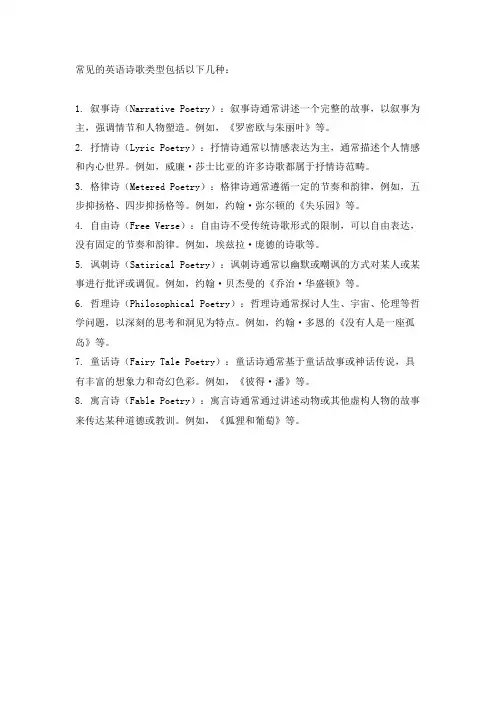
常见的英语诗歌类型包括以下几种:
1. 叙事诗(Narrative Poetry):叙事诗通常讲述一个完整的故事,以叙事为主,强调情节和人物塑造。
例如,《罗密欧与朱丽叶》等。
2. 抒情诗(Lyric Poetry):抒情诗通常以情感表达为主,通常描述个人情感和内心世界。
例如,威廉·莎士比亚的许多诗歌都属于抒情诗范畴。
3. 格律诗(Metered Poetry):格律诗通常遵循一定的节奏和韵律,例如,五步抑扬格、四步抑扬格等。
例如,约翰·弥尔顿的《失乐园》等。
4. 自由诗(Free Verse):自由诗不受传统诗歌形式的限制,可以自由表达,没有固定的节奏和韵律。
例如,埃兹拉·庞德的诗歌等。
5. 讽刺诗(Satirical Poetry):讽刺诗通常以幽默或嘲讽的方式对某人或某事进行批评或调侃。
例如,约翰·贝杰曼的《乔治·华盛顿》等。
6. 哲理诗(Philosophical Poetry):哲理诗通常探讨人生、宇宙、伦理等哲学问题,以深刻的思考和洞见为特点。
例如,约翰·多恩的《没有人是一座孤岛》等。
7. 童话诗(Fairy Tale Poetry):童话诗通常基于童话故事或神话传说,具有丰富的想象力和奇幻色彩。
例如,《彼得·潘》等。
8. 寓言诗(Fable Poetry):寓言诗通常通过讲述动物或其他虚构人物的故事来传达某种道德或教训。
例如,《狐狸和葡萄》等。
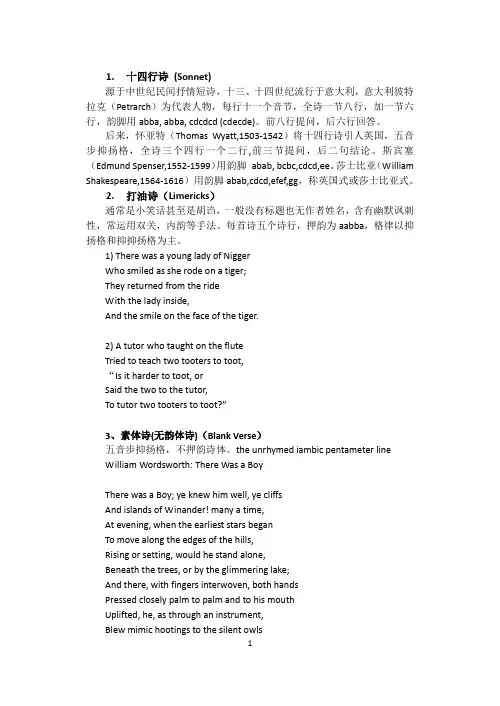
1.十四行诗(Sonnet)源于中世纪民间抒情短诗,十三、十四世纪流行于意大利,意大利彼特拉克(Petrarch)为代表人物,每行十一个音节,全诗一节八行,加一节六行,韵脚用abba, abba, cdcdcd (cdecde)。
前八行提问,后六行回答。
后来,怀亚特(Thomas Wyatt,1503-1542)将十四行诗引人英国,五音步抑扬格,全诗三个四行一个二行,前三节提问,后二句结论。
斯宾塞(Edmund Spenser,1552-1599)用韵脚abab, bcbc,cdcd,ee。
莎士比亚(William Shakespeare,1564-1616)用韵脚abab,cdcd,efef,gg,称英国式或莎士比亚式。
2.打油诗(Limericks)通常是小笑话甚至是胡诌,一般没有标题也无作者姓名,含有幽默讽刺性,常运用双关,内韵等手法。
每首诗五个诗行,押韵为aabba,格律以抑扬格和抑抑扬格为主。
1) There was a young lady of NiggerWho smiled as she rode on a tiger;They returned from the rideWith the lady inside,And the smile on the face of the tiger.2) A tutor who taught on the fluteTried to teach two tooters to toot,“Is it harder to toot, orSaid the two to the tutor,To tutor two tooters to toot?”3、素体诗(无韵体诗)(Blank Verse)五音步抑扬格,不押韵诗体。
the unrhymed iambic pentameter lineWilliam Wordsworth: There Was a BoyThere was a Boy; ye knew him well, ye cliffsAnd islands of Winander! many a time,At evening, when the earliest stars beganTo move along the edges of the hills,Rising or setting, would he stand alone,Beneath the trees, or by the glimmering lake;And there, with fingers interwoven, both handsPressed closely palm to palm and to his mouthUplifted, he, as through an instrument,Blew mimic hootings to the silent owlsThat they might answer him.—And they would shoutAcross the watery vale, and shout again,Responsive to his call,—with quivering peals,And long halloos, and screams, and echoes loudRedoubled and redoubled; concourse wildOf jocund din! And, when there came a pauseOf silence such as baffled his best skill:Then, sometimes, in that silence, while he hungListening, a gentle shock of mild surpriseHas carried far into his heart the voiceOf mountain-torrents; or the visible sceneWould enter unawares into his mindWith all its solemn imagery, its rocks,Its woods, and that uncertain heaven receivedInto the bosom of the steady lake.This boy was taken from his mates, and diedIn childhood, ere he was full twelve years old.Pre-eminent in beauty is the valeWhere he was born and bred: the churchyard hangsUpon a slope above the village-school;And through that churchyard when my way has ledOn summer-evenings, I believe that thereA long half-hour together I have stoodMute —looking at the grave in which he lies!3.自由诗(Free Verse)自由诗(Free Verse):现代诗中常见的体式,长短不同的诗行存在于同一首诗中,不讲究押韵与格律,只注重诗歌所表达的意象和传递的情感。
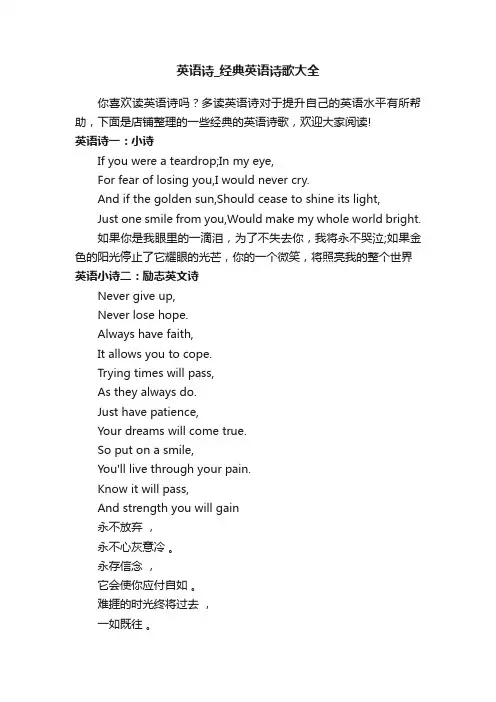
英语诗_经典英语诗歌大全你喜欢读英语诗吗?多读英语诗对于提升自己的英语水平有所帮助,下面是店铺整理的一些经典的英语诗歌,欢迎大家阅读!英语诗一:小诗If you were a teardrop;In my eye,For fear of losing you,I would never cry.And if the golden sun,Should cease to shine its light,Just one smile from you,Would make my whole world bright.如果你是我眼里的一滴泪,为了不失去你,我将永不哭泣;如果金色的阳光停止了它耀眼的光芒,你的一个微笑,将照亮我的整个世界英语小诗二:励志英文诗Never give up,Never lose hope.Always have faith,It allows you to cope.Trying times will pass,As they always do.Just have patience,Your dreams will come true.So put on a smile,You'll live through your pain.Know it will pass,And strength you will gain永不放弃,永不心灰意冷。
永存信念,它会使你应付自如。
难捱的时光终将过去,一如既往。
只要有耐心,梦想就会成真。
露出微笑,你会走出痛苦。
相信苦难定会过去,你将重获力量。
英语诗三:英语小诗Hold fast to dreams 紧紧抓住梦想,For if dreams die 梦想若是消亡Life is a broken-winged bird 生命就象鸟儿折了翅膀That can never fly. 再也不能飞翔Hold fast to dreams 紧紧抓住梦想,For when dreams go 梦想若是消丧Life is a barren field 生命就象贫瘠的荒野,Frozen only with snow 雪覆冰封,万物不再生英语诗四:英文爱情小诗If I could save time in a bottlethe first thing that I'd like to dois to save every day until eternity passes awayjust to spend them with you英语诗五:我和你等于永恒If I could save time in a bottlethe first thing that I'd like to dois to save every day until eternity passes awayjust to spend them with youIf I could make days last foreverif words could make wishes come trueI'd save every day like a treasure and thenagain I would spend them with you如果我能把时间存入一个瓶子,我要作的第一件事就是,把每一天都存下来直到永恒,再和你一起慢慢度过。
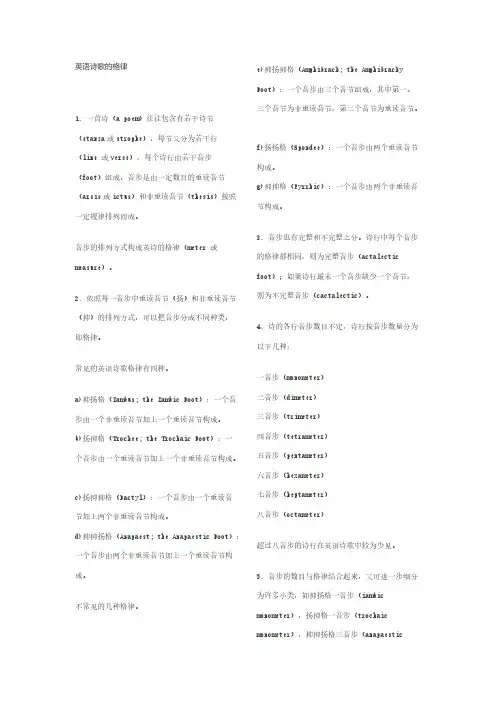
英语诗歌的格律1.一首诗(a poem)往往包含有若干诗节(stanza或strophe),每节又分为若干行(line 或verse),每个诗行由若干音步(foot)组成,音步是由一定数目的重读音节(arsis或ictus)和非重读音节(thesis)按照一定规律排列而成。
音步的排列方式构成英诗的格律(meter 或measure)。
2.依照每一音步中重读音节(扬)和非重读音节(抑)的排列方式,可以把音步分成不同种类,即格律。
常见的英语诗歌格律有四种。
a)抑扬格(Iambus; the Iambic Foot):一个音步由一个非重读音节加上一个重读音节构成。
b)扬抑格(Trochee; the Trochaic Foot):一个音步由一个重读音节加上一个非重读音节构成。
c)扬抑抑格(Dactyl):一个音步由一个重读音节加上两个非重读音节构成。
d)抑抑扬格(Anapaest; the Anapaestic Foot):一个音步由两个非重读音节加上一个重读音节构成。
不常见的几种格律。
e)抑扬抑格(Amphibrach; the Amphibrachy Foot):一个音步由三个音节组成,其中第一、三个音节为非重读音节,第二个音节为重读音节。
f)扬扬格(Spondee):一个音步由两个重读音节构成。
g)抑抑格(Pyrrhic):一个音步由两个非重读音节构成。
3.音步也有完整和不完整之分。
诗行中每个音步的格律都相同,则为完整音步(actalectic foot);如果诗行最末一个音步缺少一个音节,则为不完整音步(cactalectic)。
4.诗的各行音步数目不定,诗行按音步数量分为以下几种:一音步(monometer)二音步(dimeter)三音步(trimeter)四音步(tetrameter)五音步(pentameter)六音步(hexameter)七音步(heptameter)八音步(octameter)超过八音步的诗行在英语诗歌中较为少见。
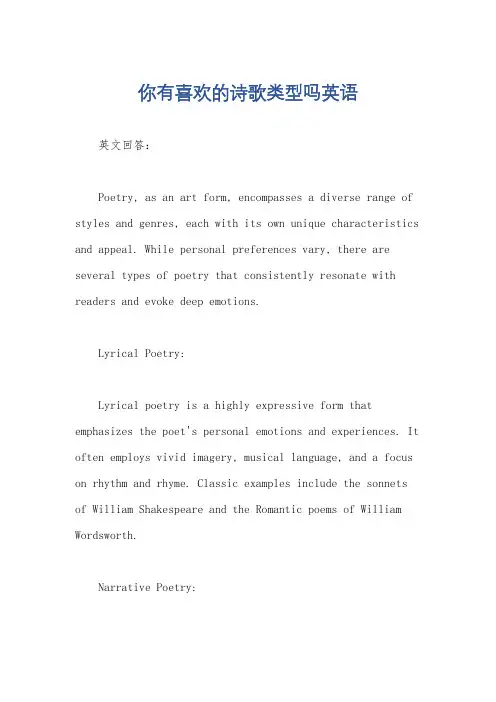
你有喜欢的诗歌类型吗英语英文回答:Poetry, as an art form, encompasses a diverse range of styles and genres, each with its own unique characteristics and appeal. While personal preferences vary, there are several types of poetry that consistently resonate with readers and evoke deep emotions.Lyrical Poetry:Lyrical poetry is a highly expressive form that emphasizes the poet's personal emotions and experiences. It often employs vivid imagery, musical language, and a focus on rhythm and rhyme. Classic examples include the sonnets of William Shakespeare and the Romantic poems of William Wordsworth.Narrative Poetry:As its name suggests, narrative poetry tells a story through verse. It can be epic in scale, such as Homer's "Iliad" or Milton's "Paradise Lost," or more intimate, like the ballads of Robert Burns.Dramatic Poetry:Dramatic poetry presents a scene or conflict through dialogue and characterization. It often takes the form of plays or monologues and is known for its emotional intensity. Examples include Shakespeare's "Hamlet" and T.S. Eliot's "The Love Song of J. Alfred Prufrock."Blank Verse Poetry:Blank verse poetry is characterized by its unrhymed iambic pentameter. It is commonly used in dramatic and narrative poems, as it provides a natural rhythm and a sense of nobility. Marlowe's "Tamburlaine" and Keats's "Endymion" are notable examples.Free Verse Poetry:Free verse poetry breaks away from traditionalstructures of rhyme and meter, allowing poets to explorenew forms of expression. It often emphasizes rhythm and cadence through the use of enjambment, repetition, and line breaks. Walt Whitman's "Leaves of Grass" and AllenGinsberg's "Howl" are influential works in this genre.Haiku Poetry:Haiku is a Japanese form of poetry consisting of three unrhymed lines of five, seven, and five syllables respectively. It typically captures a moment in nature and evokes a sense of tranquility or reflection.中文回答:喜欢的诗歌类型:抒情诗,表达诗人个人情感和经历,语言优美,节奏韵律和谐。
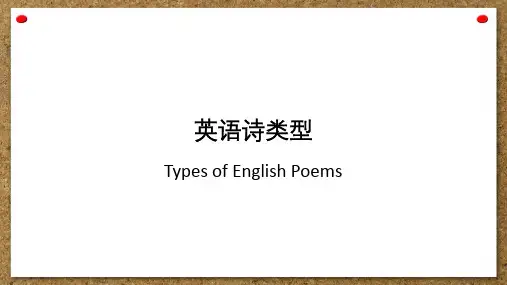
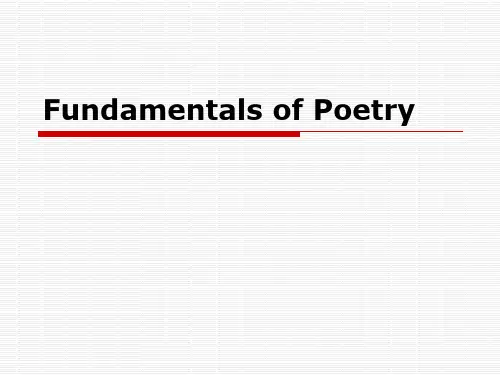

英语诗歌简明术语表A ConciseGlossaryof English Poet ryAccent 重音Allegory寓言Alliteration 头韵Allusion 典故Anapest抑抑扬格Apostrophe呼语Approximate rime近韵Assonance 半韵Ballad 民谣Ballad stanza民谣体诗节Blank verse 无韵诗,素体诗Cacophony 不和谐音Caesura行停中顿Connotation 内涵,引申义Consonance 辅音韵Cosmicirony命运反讽Couplet 对句Dactyl扬抑抑格Denotation本义Dimeter二音步诗Doggerel 打油诗Dramatic irony 戏剧性反讽Dramatic monologue 戏剧性独白End rhyme 尾韵End-stopped line行尾停顿诗行EnglishorShakespearean sonnet 英式/莎士比亚体十四行诗Enjambment跨行连续Epic史诗Euphony 谐音Exact rhyme全韵Eye rhyme 视觉韵Feminine rhyme 阴韵Figure of speech 修辞手法Fixed form固定诗体Foot音步Free verse自由诗Haiku 俳句Heroiccouplet 英雄偶句体Heptameter 七音步诗行Hexameter 六音步诗行Hyperbole夸张Iamb抑扬格Imagery意象Internal rhyme 行中韵Irony反讽,反语Italian orPetrarchan sonnet 意式/比特拉克体十四行诗Limerick 五行打油诗Literaryballad 文人民谣Lyric 抒情诗Masculinerhyme阳韵Metaphor 暗喻,隐喻Meter格律,韵律Metonymy 换喻,转喻Monometer 单音步诗行Narrative poem叙事诗Octameter八音步诗行Octave八行诗节Ode颂诗Onomatopoeia 拟声法Open form 开放诗体Overstatement 夸张Oxymoron矛盾形容法Paradox悖论Pentameter五音步诗行Personification拟人法Picturepoem涂画诗Prosepoem 散文诗Quatrain四节诗行Refrain叠句,副歌Rhyme or rime 押韵Rhyme scheme 押韵格式Rhythm节奏,韵律,格律Run-online 连续诗行Sarcasm 讥刺Satire讽刺Scansion 韵律分析,韵律图示Sestet六节诗行Simile 明喻Situationalirony 情景反讽Sonnet 十四行诗Speaker说话者Spondee扬扬格Stanza诗节Stress重音Symbol 象征Synecdoche提喻Tercet三行诗节Terzarima 三行诗节隔行押韵法Tetrameter四音步诗行Theme主题Tone 语气,语调trimeter 三音步诗行Triplet 同韵三行联句Trochee扬抑格Understatement 低调陈述,轻描淡写Verbalirony 言辞反讽Verse 散文诗Villanelle 维拉内拉体。
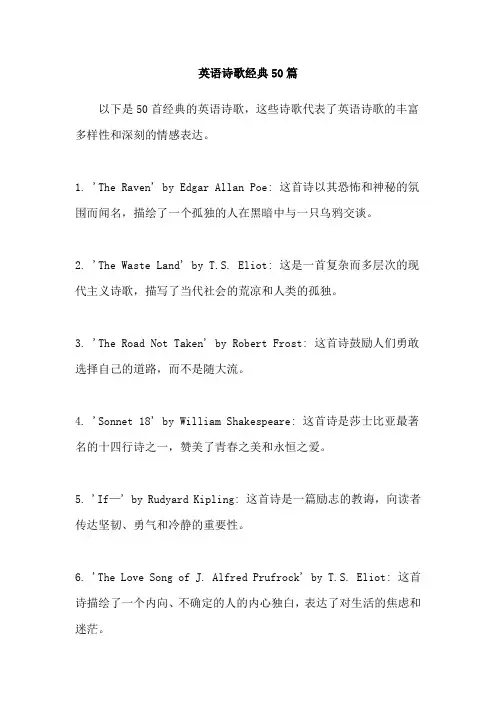
英语诗歌经典50篇以下是50首经典的英语诗歌,这些诗歌代表了英语诗歌的丰富多样性和深刻的情感表达。
1. 'The Raven' by Edgar Allan Poe: 这首诗以其恐怖和神秘的氛围而闻名,描绘了一个孤独的人在黑暗中与一只乌鸦交谈。
2. 'The Waste Land' by T.S. Eliot: 这是一首复杂而多层次的现代主义诗歌,描写了当代社会的荒凉和人类的孤独。
3. 'The Road Not Taken' by Robert Frost: 这首诗鼓励人们勇敢选择自己的道路,而不是随大流。
4. 'Sonnet 18' by William Shakespeare: 这首诗是莎士比亚最著名的十四行诗之一,赞美了青春之美和永恒之爱。
5. 'If—' by Rudyard Kipling: 这首诗是一篇励志的教诲,向读者传达坚韧、勇气和冷静的重要性。
6. 'The Love Song of J. Alfred Prufrock' by T.S. Eliot: 这首诗描绘了一个内向、不确定的人的内心独白,表达了对生活的焦虑和迷茫。
7. 'Annabel Lee' by Edgar Allan Poe: 这首诗是一首悲伤的爱情诗,描写了主人公对他已故的心爱之人的深情。
8. 'Ode to a Nightingale' by John Keats: 这首诗以其优美的语言和对死亡的思考而闻名,表达了对美和永恒的追求。
9. 'The Second Coming' by W.B. Yeats: 这首诗描述了一种混乱和不稳定的时代即将来临的预感。
10. 'The Lady of Shalott' by Alfred, Lord Tennyson: 这首诗描绘了一个被囚禁在塔中的女人的悲剧命运。

英语诗歌的格律1.一首诗(a poem)往往包含有若干诗节(stanze 或strophe ),每节又分为若干行(line 或verse ),每个诗行由若干音步(foot )组成,音步则是由一定数目的重读音节(arsis 或ictus )和非重读音节(thesis )按照一定规律排列而成。
音步的排列方式构成英诗的格律(meter 或measure )。
2.依照每一音步中重读音节(扬)和非重读音节(抑)的排列方式,可以把音步分成不同种类,即格律。
常见的英语诗歌格律有四种。
a) 抑扬格(Iambus ;the Iambic Foot ):一个音步由一个非重读音节加上一个重读音节构成。
b) 扬抑格(Trochee ;the Trochaic Foot ):一个音步由一个重读音节加上一个非重读音节构成。
c) 扬抑抑格(Dactyl ):一个音步由一个重读音节加上两个非重读音节构成。
d) 抑抑扬格(Anapaest ;theAnapaesticFoot ):一个音步由两个非重读音节加上一个重读音节构成。
不常见的几种格律。
e) 抑扬抑格(Amphibrach ;theAmphibrachyFoot ):一个音步由三个音节组成,其中第一、三个音节为非重读音节,第二个音节为重读音节。
f) 扬扬格(Spondee ):一个音步由两个重读音节构成。
g) 抑抑格(Pyrrhic ):一个音步由两个非重读音节构成。
3.音步也有完整和不完整之分。
诗行中每个音步的格律都相同,则为完整音步(actalecticfoot );如果诗行最末一个音步缺少一个音节,则为不完整音步(cactalectic )。
4.诗的各行音步数目不定,诗行按音步数量分为以下几种:一音步(monometer )二音步(dimeter )三音步(trimeter )四音步(tetrameter )五音步(pentameter )六音步(hexameter )七音步(heptameter )八音步(octameter )超过八音步的诗行在英语诗歌中较为少见。

1.十四行诗(Sonnet)源于中世纪民间抒情短诗,十三、十四世纪流行于意大利,意大利彼特拉克(Petrarch)为代表人物,每行十一个音节,全诗一节八行,加一节六行,韵脚用abba, abba, cdcdcd (cdecde)。
前八行提问,后六行回答。
后来,怀亚特(Thomas Wyatt,1503-1542)将十四行诗引人英国,五音步抑扬格,全诗三个四行一个二行,前三节提问,后二句结论。
斯宾塞(Edmund Spenser,1552-1599)用韵脚abab, bcbc,cdcd,ee。
莎士比亚(William Shakespeare,1564-1616)用韵脚abab,cdcd,efef,gg,称英国式或莎士比亚式。
2.打油诗(Limericks)通常是小笑话甚至是胡诌,一般没有标题也无作者姓名,含有幽默讽刺性,常运用双关,内韵等手法。
每首诗五个诗行,押韵为aabba,格律以抑扬格和抑抑扬格为主。
1) There was a young lady of NiggerWho smiled as she rode on a tiger;They returned from the rideWith the lady inside,And the smile on the face of the tiger.2) A tutor who taught on the fluteTried to teach two tooters to toot,“Is it harder to toot, orSaid the two to the tutor,To tutor two tooters to toot?”3、素体诗(无韵体诗)(Blank Verse)五音步抑扬格,不押韵诗体。
the unrhymed iambic pentameter lineWilliam Wordsworth: There Was a BoyThere was a Boy; ye knew him well, ye cliffsAnd islands of Winander! many a time,At evening, when the earliest stars beganTo move along the edges of the hills,Rising or setting, would he stand alone,Beneath the trees, or by the glimmering lake;And there, with fingers interwoven, both handsPressed closely palm to palm and to his mouthUplifted, he, as through an instrument,Blew mimic hootings to the silent owlsThat they might answer him.—And they would shoutAcross the watery vale, and shout again,Responsive to his call,—with quivering peals,And long halloos, and screams, and echoes loudRedoubled and redoubled; concourse wildOf jocund din! And, when there came a pauseOf silence such as baffled his best skill:Then, sometimes, in that silence, while he hungListening, a gentle shock of mild surpriseHas carried far into his heart the voiceOf mountain-torrents; or the visible sceneWould enter unawares into his mindWith all its solemn imagery, its rocks,Its woods, and that uncertain heaven receivedInto the bosom of the steady lake.This boy was taken from his mates, and diedIn childhood, ere he was full twelve years old.Pre-eminent in beauty is the valeWhere he was born and bred: the churchyard hangsUpon a slope above the village-school;And through that churchyard when my way has ledOn summer-evenings, I believe that thereA long half-hour together I have stoodMute —looking at the grave in which he lies!3.自由诗(Free Verse)自由诗(Free Verse):现代诗中常见的体式,长短不同的诗行存在于同一首诗中,不讲究押韵与格律,只注重诗歌所表达的意象和传递的情感。
英文诗体裁[一] 诗的格律等知识一、诗的格律格律是指可以用脚打拍子的节奏”,是每个音步轻重音节排列的格式,也是朗读时轻重音的依据。
而音步是由重读音节和非重读音节构成的诗的分析单位。
重读音节为扬(重),在音节上用“-”或“ˊ”标示,非重读音节为抑(轻),在音节上用“)”标示,音步之间可用“/”隔开。
以下是五种常见格式:1.抑扬格(轻重格)Iambus:是最常见的一种格式,每个音步由一个非重读音节加一个重读音节构成。
As fair / art thou / my bon/nie lass,So deep / in luve / am I :And I / will luve / thee still,/ my dear,Till a` / the seas / gang dry:Robert Burns(1759-1796): My Luve Is like a Red, Red Rose注;art=are;luve=love???bonnie=beautiful???a`=all???gang=go上例中为四音步与三音步交叉,可标示为:)-/)-/)-/()-)2.扬抑格(重轻格)Trochee:每个音步由一个重读音节加一个非重读音节构成。
下例中为四音步扬抑格(少一个轻音节),可标示为:-)/-)/-)/-Tyger!/ Tyger!/ burning / brightIn the / forests / of the / nightWilliam Blake: The Tyger3.抑抑扬格(轻轻重格)Anapaestic foot: 每个音步由两个非重读音节加一个重读音节构成。
如:三音步抑抑扬格))-/))-/))-Like a child / from the womb,Like a ghost / from the tomb,I arise / and unbuild / it again.4.扬抑抑格(重轻轻格)Dactylic foot:?每个音步由一个重读音节加两个非重读音节构成。
英文诗歌作品欣赏一、诗歌基本知识1.诗歌的定义:诗歌是一种文学形式,以节奏、韵律和音乐性为主要特征,表达作者的情感、思想和观点。
2.诗歌的分类:根据韵律和节奏,诗歌可分为自由诗、押韵诗、抒情诗、叙事诗等。
3.诗歌的结构:诗歌一般分为节、行、句,其中节是诗歌的基本单位,行是节的组成部分,句是行的组成部分。
二、英文诗歌特点1.英文诗歌的韵律:英文诗歌主要依靠音节、重音和停顿来形成韵律,不同于中文诗歌的平仄和押韵。
2.英文诗歌的押韵:英文诗歌的押韵方式多样,如押尾韵、押头韵、押元音韵等。
3.英文诗歌的象征和隐喻:英文诗歌中广泛使用象征和隐喻手法,以增强表达效果和深化主题。
三、著名英文诗歌作品1.莎士比亚的《十四行诗》:莎士比亚的十四行诗以其优美的韵律和深刻的哲理闻名于世。
2.雪莱的《西风颂》:该诗以生动的自然景象抒发了诗人对自由、平等和正义的追求。
3.弗罗斯特的《未选择的路》:该诗通过描述两条路的选择,表达了人生的哲理。
4.狄金森的《因为我不能停下来死亡》:该诗以独特的视角和手法探讨了生与死的关系。
四、诗歌欣赏方法1.朗读:通过朗读,感受诗歌的韵律和节奏,体会诗人的情感。
2.解析:分析诗歌的结构、意象、象征和隐喻,理解诗歌的主题和内涵。
3.想象:发挥想象力,置身于诗歌描绘的情景中,与诗人产生共鸣。
4.创作:尝试创作诗歌,锻炼自己的表达能力,深入理解诗歌艺术。
五、诗歌在中小学教育中的重要性1.培养审美能力:诗歌欣赏有助于提高学生的审美情趣和审美能力。
2.提高语言素养:通过学习诗歌,学生可以提高词汇量、增强语言表达能力。
3.陶冶情操:诗歌中的美和哲理有助于培养学生高尚的情操和健康的人格。
4.传承文化:诗歌是民族文化的重要组成部分,学习诗歌有助于传承和弘扬文化。
英文诗歌作品欣赏是一种富有韵律美和哲理性的文学艺术。
通过学习诗歌,学生可以提高语言素养、培养审美能力和陶冶情操,同时深入了解民族文化。
在我国中小学教育中,诗歌教育具有重要意义,应大力推广和普及。
The Rhythm and T ypes of English Poetry英语诗歌的韵律与类型目录上篇英语诗歌的韵律前言.............................................(第一章英语诗歌的韵步.............................(第一节韵步的定义与类型.......................(第二节韵步类型举例...........................(第二章英语诗歌的韵步数............................(第一节单韵步行...............................(第二节双韵步行...............................(第三节三韵步行和四韵步行.....................(第四节五韵步行...............................(第五节六韵步行...............................(第六节七韵步行...............................(第七节八韵步行...............................(第三章英语诗歌的押韵..............................(第一节头韵...................................(第二节尾韵...................................(第三节内韵...................................(第四节元韵...................................(第五节和韵...................................(第六节目韵...................................(第四章英语诗歌的基本押韵格式......................(第一节基本押韵格式...........................(第二节基本押韵格式的组合使用.................(第五章十四行诗的押韵格式.......................(第一节彼特拉克体..........................(第二节莎士比亚体..........................(第三节斯宾塞体............................(第六章诗行与韵律...............................(第一节结句行..............................(第二节连续行..............................(第三节音节增减............................(第四节句式倒装............................(第七章五行打油诗与短回旋诗.....................(第一节五行打油诗..........................(第二节短回旋诗............................(第八章素体诗与自由诗...........................(第一节素体诗..............................(第二节自由诗..............................(下篇英语诗歌的类型第九章叙事诗...................................(第一节史诗.................................(第二节歌谣.................................(第三节戏剧诗...............................(第四节故事诗...............................(第十章抒情诗...................................(第一节颂诗..................................(第二节挽歌..................................(第三节婚庆曲................................(第四节歌..................................(第五节田园短诗............................(第六节田园牧歌............................(第七节爱情小诗............................(第八节哲理诗..............................(第九节宗教诗..............................(第十节赞美诗..............................(第十一节墓志铭.............................(第十二节收场白............................(第十一章融入中国文化的英语诗歌.................(前言《英语诗歌的韵律与类型》是出于教学的需要而编写的。
英文诗体裁[一] 诗的格律等知识一、诗的格律格律是指可以用脚打拍子的节奏”,是每个音步轻重音节排列的格式,也是朗读时轻重音的依据。
而音步是由重读音节和非重读音节构成的诗的分析单位。
重读音节为扬(重),在音节上用“-”或“ˊ”标示,非重读音节为抑(轻),在音节上用“)”标示,音步之间可用“/”隔开。
以下是五种常见格式:1.抑扬格(轻重格)Iambus:是最常见的一种格式,每个音步由一个非重读音节加一个重读音节构成。
As fair / art thou / my bon/nie lass,So deep / in luve / am I :And I / will luve / thee still,/ my dear,Till a` / the seas / gang dry:Robert Burns(1759-1796): My Luve Is like a Red, Red Rose注;art=are;luve=lovebonnie=beautifula`=allgang=go上例中为四音步与三音步交叉,可标示为:)-/)-/)-/()-)2.扬抑格(重轻格)Trochee:每个音步由一个重读音节加一个非重读音节构成。
下例中为四音步扬抑格(少一个轻音节),可标示为:-)/-)/-)/-Tyger!/ Tyger!/ burning / brightIn the / forests / of the / nightWilliam Blake: The Tyger3.抑抑扬格(轻轻重格)Anapaestic foot: 每个音步由两个非重读音节加一个重读音节构成。
如:三音步抑抑扬格))-/))-/))-Like a child / from the womb,Like a ghost / from the tomb,I arise / and unbuild / it again.4.扬抑抑格(重轻轻格)Dactylic foot:?每个音步由一个重读音节加两个非重读音节构成。
英国文学诗歌期末整理版一、Basic elements1.节奏:一重读音节与一或个轻读音节按一定的模式搭配,有规律地反复出现。
2.轻重读:凡是有两个以上音节的英文单词,根据语法、语调、语意的要求,分为重读与轻读。
3.节奏:重读音节和轻读音节,按一定模式配合,反复再现,抑扬顿挫,就形成了诗歌的节奏。
多音节单词有重音和次重音,次重音根据节奏既可视为重读,也可视为轻读。
Alone │she cuts │and binds│ the grain,And sings │a me│lancho│ly strain.这两行诗的重读与轻读的固定搭配模式是:轻——重。
在每行中再现四次,这样就形成了这两行诗的节奏。
4.音步:某种固定的轻重搭配叫“音步”(foot),相当与乐谱中的“小节”。
5.音部数:一行诗中轻重搭配出现的次数叫音步数。
二.常见的音步类型(轻读是“抑”,重读是“扬”)根据重读与轻读搭配的方式的不同,可划分不同的音步类型,节奏自然也不同。
最常见的音步类型有以下四种:1.抑扬格(iamb, iambic)若一个音步中有两个音节,前者为轻,后者为重2. 扬抑格(trochee, trochaic)若一音步中有两个音节,前者为重,后者为轻。
Present │mirth has │present │laughterShake your │chains to │earth like │dew3.抑抑扬格(Anapaest, anapaestic)抑抑扬格含三个音节,即轻——轻——重。
The Assyr│ian came down │like the wolf │on the fold,And his coh│orts were glea│ming in purp│le and gold;And the sheen│of their spears│was like stars│on the sea,When the blue │waves rolls night│ly on deep │Galile e.4.扬抑抑格(dactyl, dactylic).重——轻——轻Dragging the │corn by her │golden hair.抑抑格(pyrrhic[/peirik]和扬扬格(spondee[/sp :ndi])以抑扬格为主要节奏写成的,就称此诗为抑扬格诗。